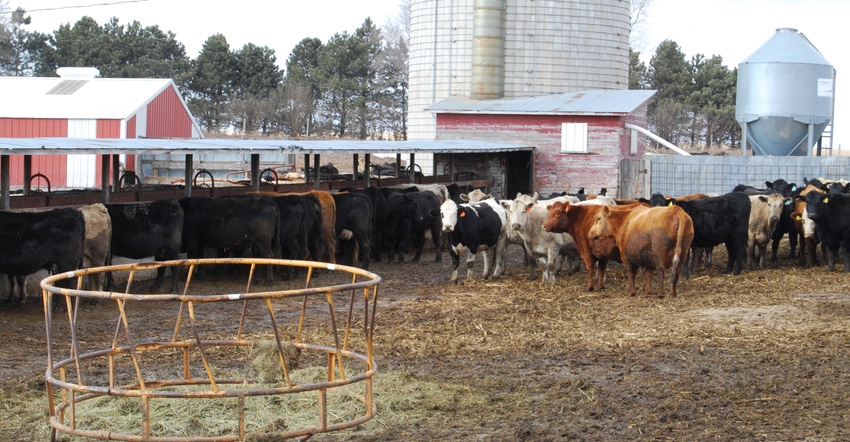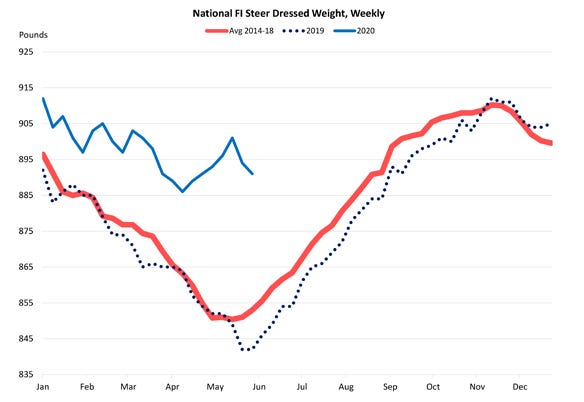June 17, 2020

As summer progresses, a wall of cattle will keep coming. Holding slaughter weights down will be difficult but crucial. Cattle producers will need to be especially vigilant in assessing and mitigating possible heat stress. Slaughter weights are likely to remain heavy through year-end, which will be perilous in the event of further disruptions in slaughter capacity.
Slaughter rates will need to rise dramatically to work through the large supplies of cattle available, including both on-time marketings and the backlog of cattle that has developed. If feedlots and packers can work through the heavy cattle, potential exists for a rally and a fundamentally stronger cattle market.
Even absent slaughter capacity disruptions, feedlots tend to keep cattle on feed longer during volatile market times. Lower feed prices also encourage packing on pounds, everything else constant. Within reason, time can be a friend to cattle feeders. The market may turn and strengthen. But holding brings higher slaughter weights. This, itself, can create a backlog of cattle. The longer the instability persists, the more potential exists to build surplus supplies.
Early optimism squelched
No backlog existed in early 2020. Supplies roughly in balance with demand fueled optimism for feedlot profits. In January, April live cattle futures traded in the mid-$120s. The contract weakened a bit in February, but still averaged $117 per cwt for the month. Then the surging COVID-19 pandemic torpedoed the market. The April contract averaged $102 in March and $90 in April. The price collapse wiped $500 per head off the feedlot balance sheet from January to April.
Still, cattle producers continued to market. March federally inspected (FI) steer and heifer slaughter topped March 2019 by 13%, according to the USDA National Agricultural Statistics Service’s Monthly Livestock Slaughter report. The March ramp-up in slaughter helped fill the surge in consumer demand at retail stores. But collapsing food service demand and surging unemployment numbers left the cattle market in turmoil. Sellers were taking advantage of basis. It tends to strengthen in such situations as futures overreact lower. A strong basis tells feeders to market cattle and take the basis.
But disruptions at slaughter plants obviously reduce demand for fed cattle. Cattle feeders have no control over that development.
Capacity crunch a crisis
The first shocks to beef packing plant capacity in early April created a predicament. Looming threats of further plant closures created a crisis. Disruptions in slaughter facilities escalated throughout April and peaked in early May. National FI steer and heifer slaughter for the week ending May 2 plunged 41% below the same week in 2019. The industry is crawling toward normal with FI slaughter for the week ending June 13 down just 4%. Still, about 1.1 million cattle remain backed up in U.S. feedlots.
Slaughter levels have gotten most of the attention, for good reason. Watching slaughter weights is also critical. Weights can indicate whether feedlots are keeping marketings current, pulling cattle ahead or delaying sales. In the current situation, weights can also speak to feedlot managers slowing growth rates, and sorting or topping-off of cattle in a pen at market time.
A commonly quoted weight series is the steer dressed weight in the USDA Market News Service Actual Slaughter Under Federal Inspection (SJ_LS711) report. Every Thursday, it provides data for two weeks prior. For the week ending May 30, the national average dressed weight of steers was 891 pounds. Using a 63% dressing percentage, this would equate to a 1,414-pound live steer. This is lighter than the average weight for the previous four weeks but is 49 carcass weight pounds above the average weight for the same week in 2019. All but one week of reported steer dressed weights in 2020 have set records for their respective weeks.

Well-publicized slaughter disruptions compelled feedlots to delay marketing finished cattle resulting in a backlog of heavy cattle. (Source: USDA Market News Service)
In late-April and most of May, producers were marketing cattle as quickly as they could, but they still weren’t able to keep up with growth rates. In late-May, weights began to decline as producers implemented management strategies to slow growth to delay marketings to better align cattle slaughter with recovering, though still reduced, slaughter capacity. It takes many weeks to effectively curb weights and yield results that will show up in aggregately reported data.
Understand slaughter seasonality
Weights should dip into early summer. But lower weights may not signal easing in the backlog of cattle.
Dressed weights normally decline into May. For the past 10 years, steer dressed weights in May ran 39 pounds lower compared to early January. Even though 2020 has been anything but normal, weights are still falling seasonally. The low point in steer dressed weights so far this year was for the week ending April 11 at 886 pounds.
The reason weights typically decline into May is cattle that went on feed as calves begin coming back to market. Calves typically finish at lighter weights. Grain-finished cattle are typically harvested between 12 and 24 months of age. Roughly three-quarters of the U.S. calf crop is born in the first half of the year. Calf-feds typically are 12 to 16 months old at harvest, depending upon length of the finishing period. Most cattle fed as yearlings or long-yearlings are harvested between 16 and 24 months of age.
Fed cattle that were recently marketed and cattle currently on feed were placed on feed at heavier weights than the year prior, according to the National Ag Statistics Service’s Cattle on Feed reports. Cattle placed on feed at heavier weights will tend to finish at heavier weights. But this would have only caused a marginal rise in slaughter weights. If the aggressive marketings that occurred in March would have persisted, weights would be in check now.
Nationally, April feedlot placements plunged 22% from April 2019 levels. Lower April placements will tighten finished cattle supplies and ease the slaughter capacity crunch at some point. But cattle not placed in April are still out there somewhere.
Fed cattle heaviest here
National dressed weights do not relay the entire quandary. That’s why I prefer to use Livestock Mandatory Reporting (LMR) data provided by USDA’s Ag Marketing Service in the weekly direct regional reports. Iowa-Minnesota fed cattle typically have some of the heaviest slaughter weights in the country and do now. Using live weights best describes the situation on the farm.
For the second week of June, Iowa-Minnesota steer live weights averaged 1,479 pounds. Based on reported dressed weight sales and average dressing percentages for live cattle sales, this was a 937-pound dressed weight. This is 99 pounds live and 68 pounds dressed heavier than the same week a year ago.
Negotiated sales tend to have the heaviest weights. And while formula and forward-contract weights have declined over the past couple of weeks, negotiated weights have only steadied. The 1,479-pound average steer live weight is a weighted average of weights of negotiated, formula, forward-contract and negotiated grid purchases.
Auction sales are another set of weights that I watch. USDA-IA Department of Ag Market News market reporters gather auction data for the Iowa Weekly Cattle Auction Summary report. For the week ending June 4, slaughter beef steers averaged 1,454 pounds.
Outliers do exist. One slaughter steer weighed 2,200 pounds, another weighed 1,945, and two weighed 1,845. This is the first time I recall seeing market reporters specially provide comments of “Heavy weight” for some sales.
Schulz is the ISU Extension livestock marketing economist. Send email to [email protected].
About the Author(s)
You May Also Like






